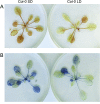Coordination of plastid and light signaling pathways upon development of Arabidopsis leaves under various photoperiods
- PMID: 22199239
- PMCID: PMC3399700
- DOI: 10.1093/mp/ssr106
Coordination of plastid and light signaling pathways upon development of Arabidopsis leaves under various photoperiods
Abstract
Plants synchronize their cellular and physiological functions according to the photoperiod (the length of the light period) in the cycle of 24 h. Photoperiod adjusts several traits in the plant life cycle, including flowering and senescence in annuals and seasonal growth cessation in perennials. Photoperiodic development is controlled by the coordinated action of photoreceptors and the circadian clock. During the past 10 years, remarkable progress has been made in understanding the molecular mechanism of the circadian clock, especially with regard to the transition of Arabidopsis from the vegetative growth to the reproductive phase. Besides flowering photoperiod also modifies plant photosynthetic structures and traits. Light signals controlling biogenesis of chloroplasts and development of leaf photosynthetic structures are perceived both by photoreceptors and in chloroplasts. In this review, we provide evidence suggesting that the photoperiodic development of Arabidopsis leaves mimics the acclimation of plant to various light intensities. Furthermore, the chloroplast-to-nucleus retrograde signals that adjust acclimation to light intensity are proposed to contribute also to the signaling pathways that control photoperiodic acclimation of leaves.
Figures



Similar articles
-
Light fluence rate and chloroplasts are sources of signals controlling mesophyll cell morphogenesis and division.Cell Biol Int. 2008 May;32(5):563-5. doi: 10.1016/j.cellbi.2007.11.011. Epub 2007 Nov 21. Cell Biol Int. 2008. PMID: 18155614
-
Light intensity-dependent retrograde signalling in higher plants.J Plant Physiol. 2013 Nov 15;170(17):1501-16. doi: 10.1016/j.jplph.2013.06.005. Epub 2013 Jul 10. J Plant Physiol. 2013. PMID: 23850030 Review.
-
Chloroplast NADPH-thioredoxin reductase interacts with photoperiodic development in Arabidopsis.Plant Physiol. 2009 Mar;149(3):1261-76. doi: 10.1104/pp.108.133777. Epub 2009 Jan 16. Plant Physiol. 2009. PMID: 19151130 Free PMC article.
-
The Arabidopsis ELF3 gene regulates vegetative photomorphogenesis and the photoperiodic induction of flowering.Plant J. 1996 Oct;10(4):691-702. doi: 10.1046/j.1365-313x.1996.10040691.x. Plant J. 1996. PMID: 8893545
-
Time to flower: interplay between photoperiod and the circadian clock.J Exp Bot. 2015 Feb;66(3):719-30. doi: 10.1093/jxb/eru441. Epub 2014 Nov 4. J Exp Bot. 2015. PMID: 25371508 Review.
Cited by
-
A telomere-to-telomere gapless genome reveals SlPRR1 control of circadian rhythm and photoperiodic flowering in tomato.Gigascience. 2025 Jan 6;14:giaf058. doi: 10.1093/gigascience/giaf058. Gigascience. 2025. PMID: 40601421 Free PMC article.
-
Arabidopsis FHY3/CPD45 regulates far-red light signaling and chloroplast division in parallel.Sci Rep. 2015 Apr 15;5:9612. doi: 10.1038/srep09612. Sci Rep. 2015. PMID: 25872642 Free PMC article.
-
Alternative Splicing Substantially Diversifies the Transcriptome during Early Photomorphogenesis and Correlates with the Energy Availability in Arabidopsis.Plant Cell. 2016 Nov;28(11):2715-2734. doi: 10.1105/tpc.16.00508. Epub 2016 Nov 1. Plant Cell. 2016. PMID: 27803310 Free PMC article.
-
Chloroplast thioredoxin systems dynamically regulate photosynthesis in plants.Biochem J. 2019 Apr 15;476(7):1159-1172. doi: 10.1042/BCJ20180707. Biochem J. 2019. PMID: 30988137 Free PMC article. Review.
-
Recent Advances in Carbon and Nitrogen Metabolism in C3 Plants.Int J Mol Sci. 2020 Dec 30;22(1):318. doi: 10.3390/ijms22010318. Int J Mol Sci. 2020. PMID: 33396811 Free PMC article. Review.
References
-
- Akhtar TA, Lees HA, Lampi MA, Enstone D, Brain RA, Greenberg BM. Photosynthetic redox imbalance influences flavonoid biosynthesis in Lemna gibba . Plant Cell Environ. 2010;33:1205–1219. - PubMed
-
- Allan AC, Hellens RP, Laing WA. MYB transcription factors that colour our fruit. Trends Plant Sci. 2008;13:99–102. - PubMed
-
- Aseeva E, et al. Vipp1 is required for basic thylakoid membrane formation but not for the assembly of thylakoid protein complexes. Plant Physiol. Biochem. 2007;45:119–128. - PubMed
-
- Bae G, Choi G. Decoding of light signals by plant phytochromes and their interacting proteins. Annu. Rev. Plant Biol. 2008;59:281–311. - PubMed
Publication types
MeSH terms
LinkOut - more resources
Full Text Sources
Molecular Biology Databases
Miscellaneous

